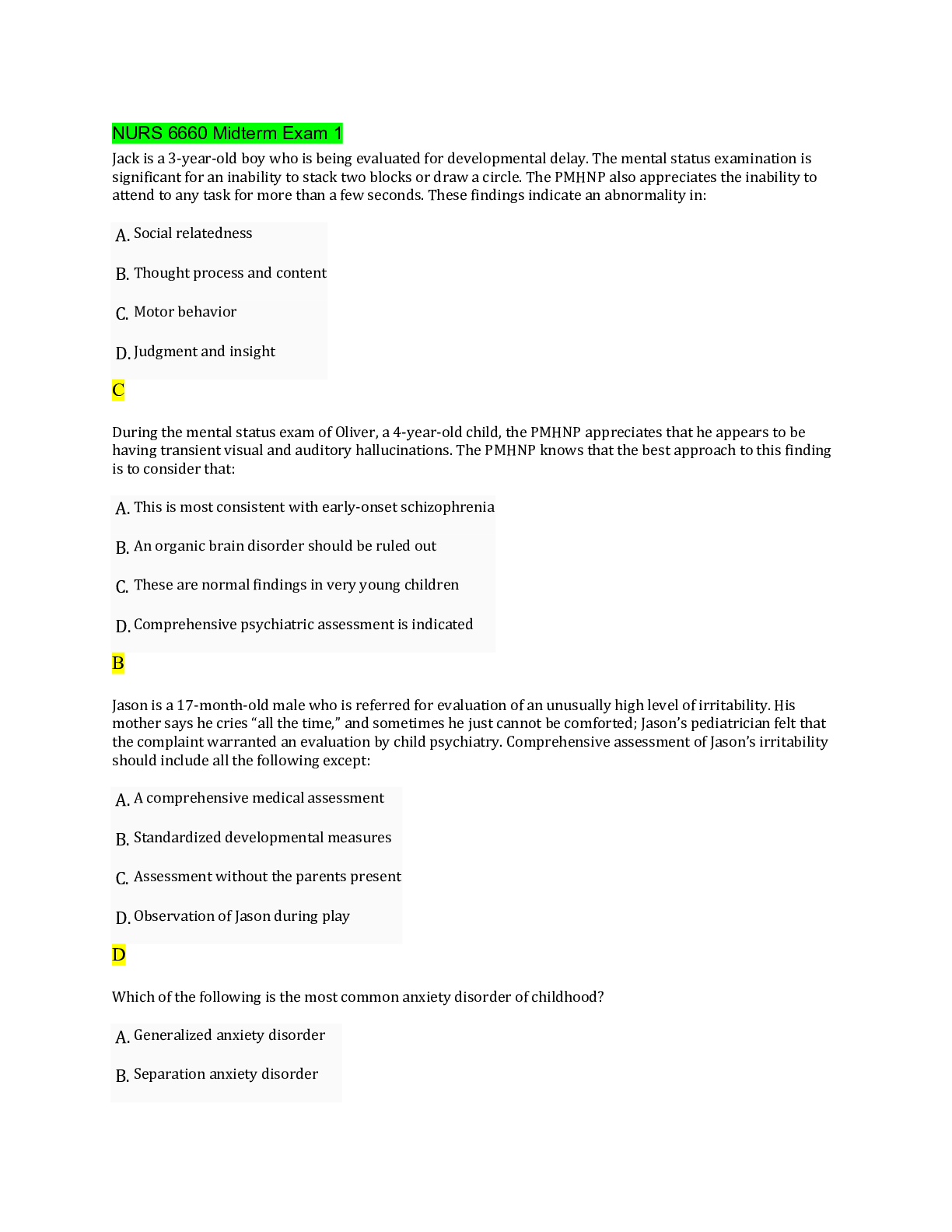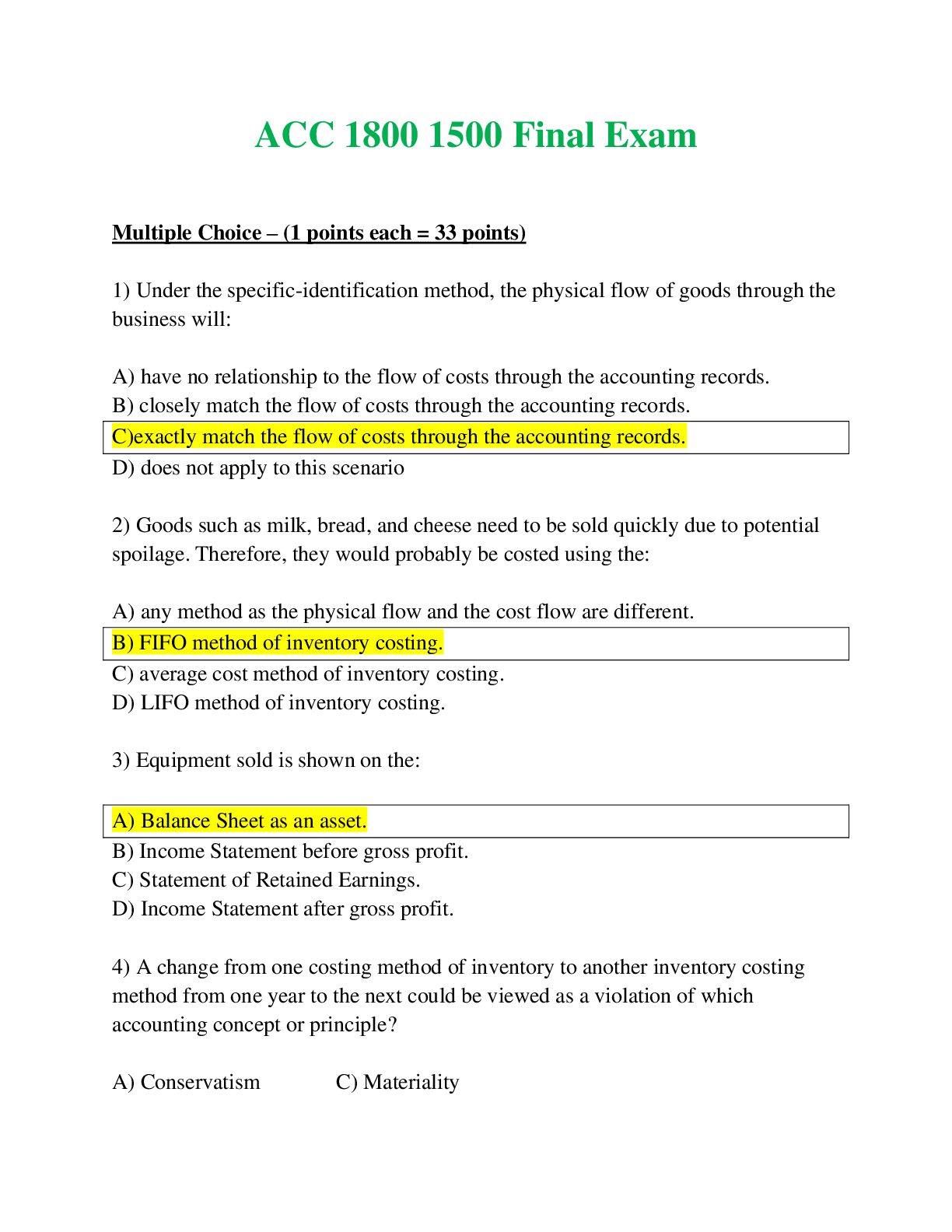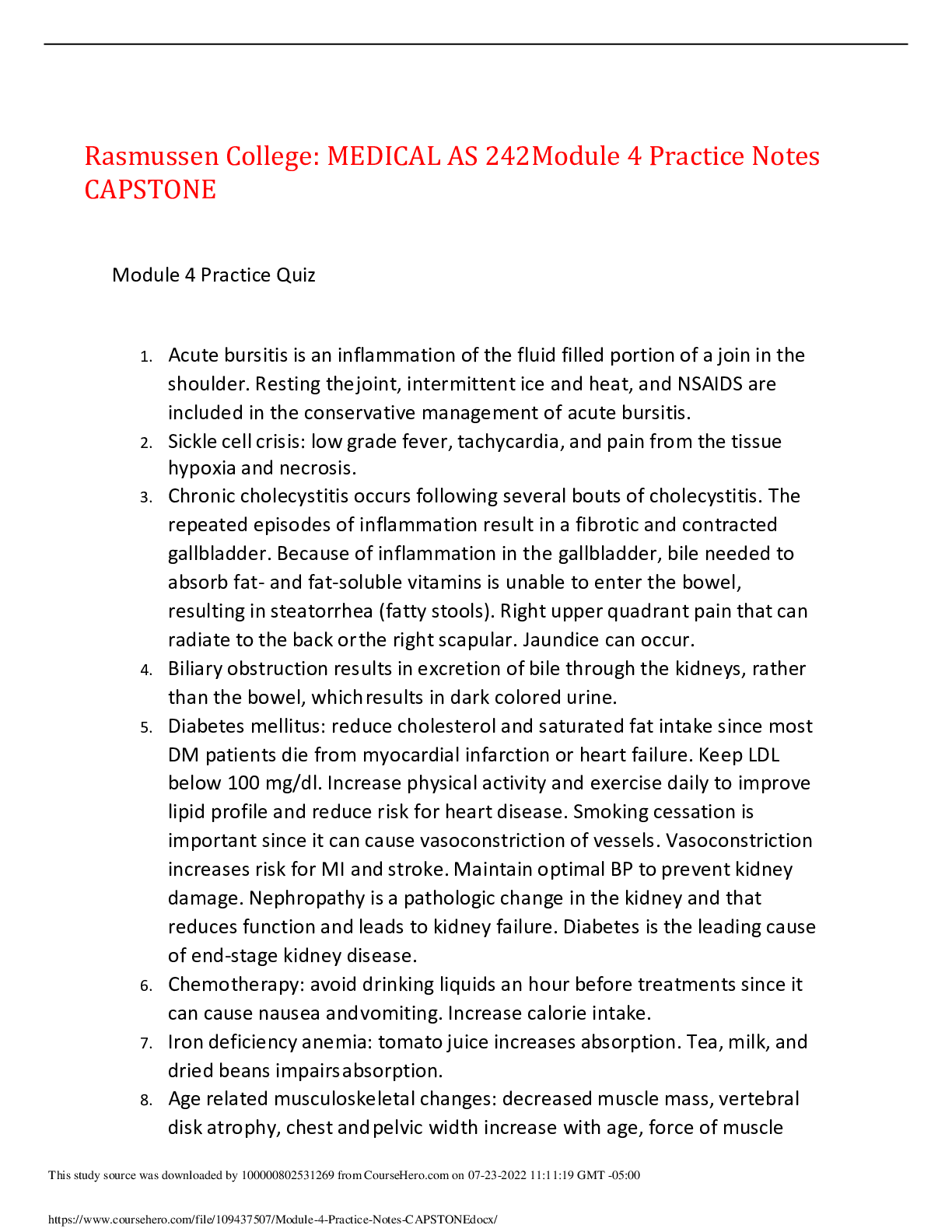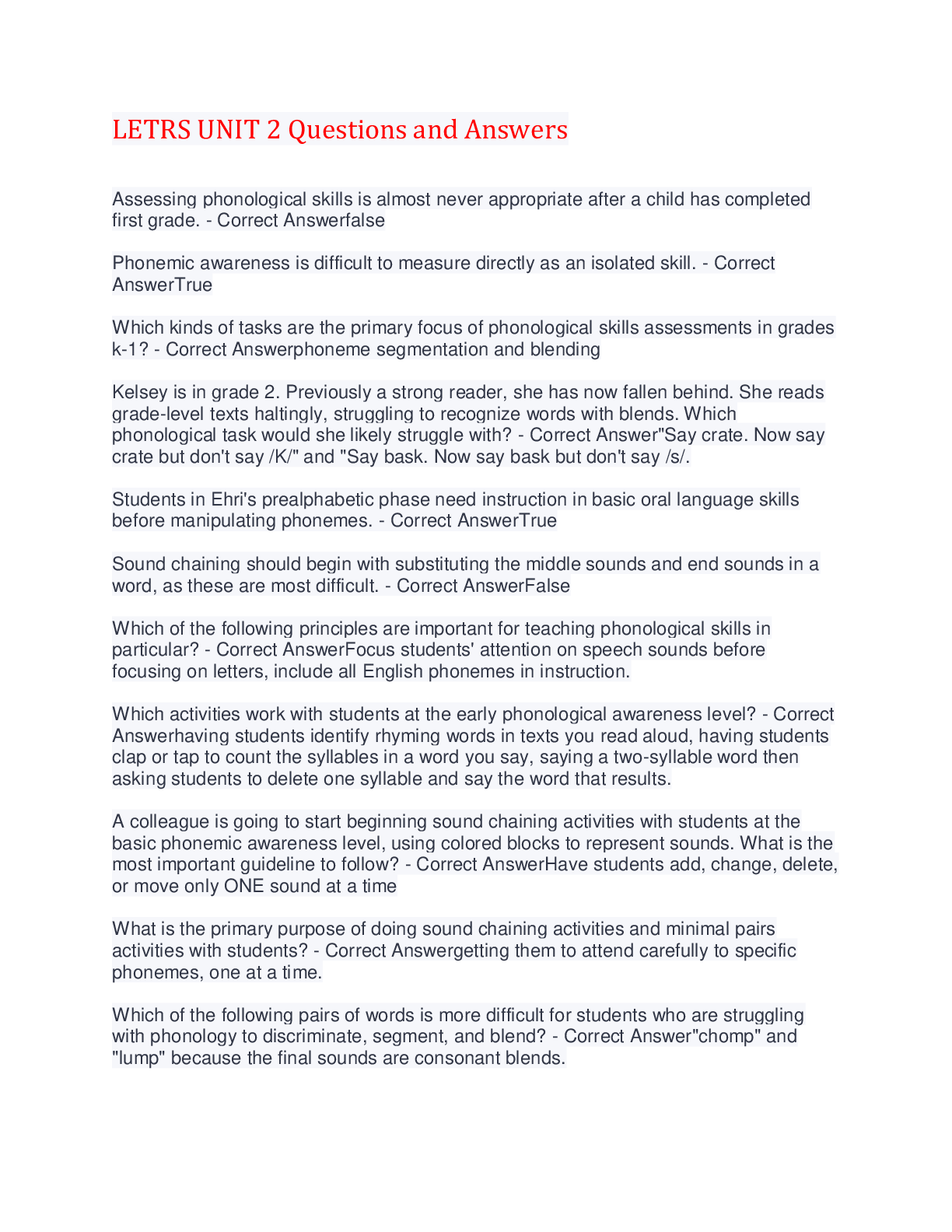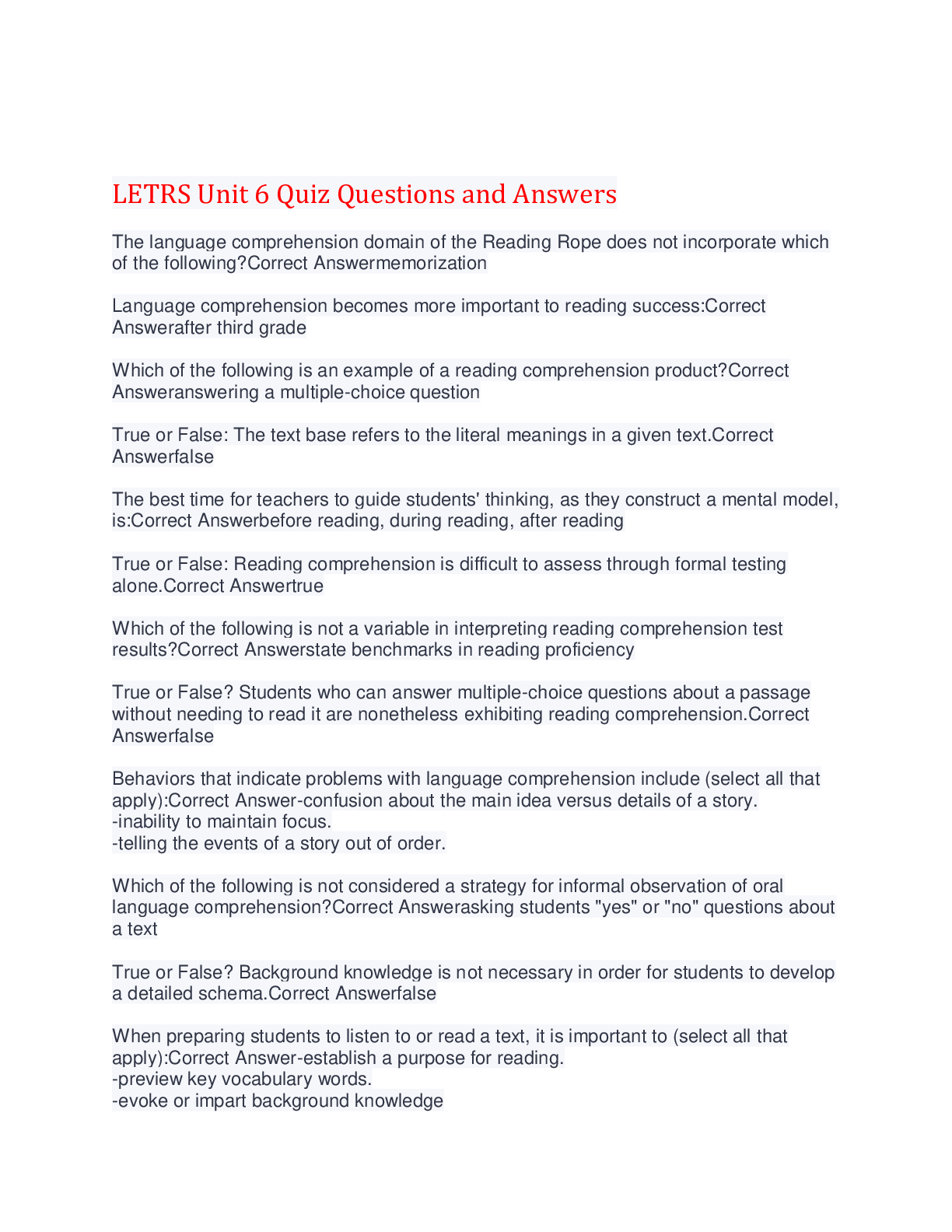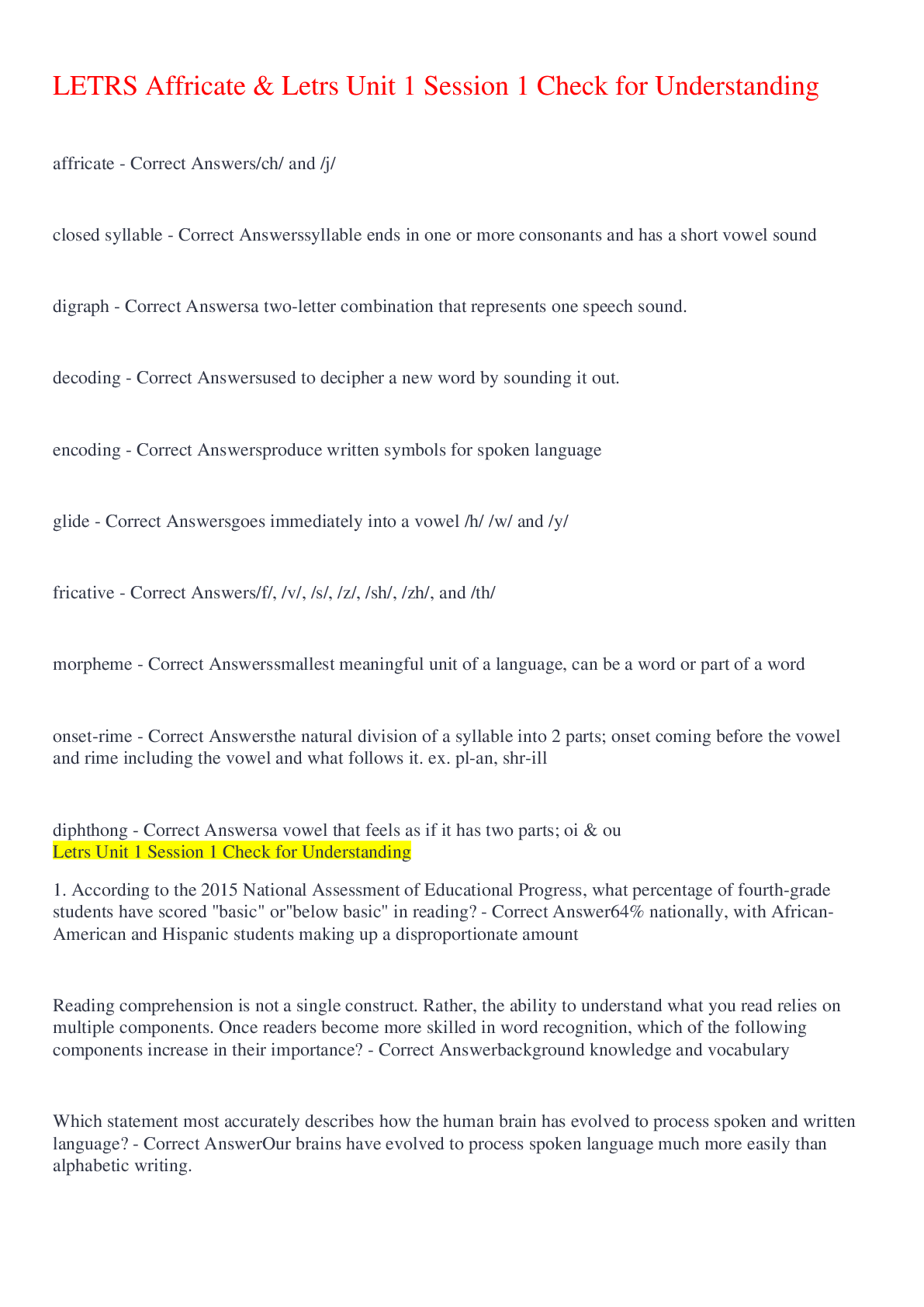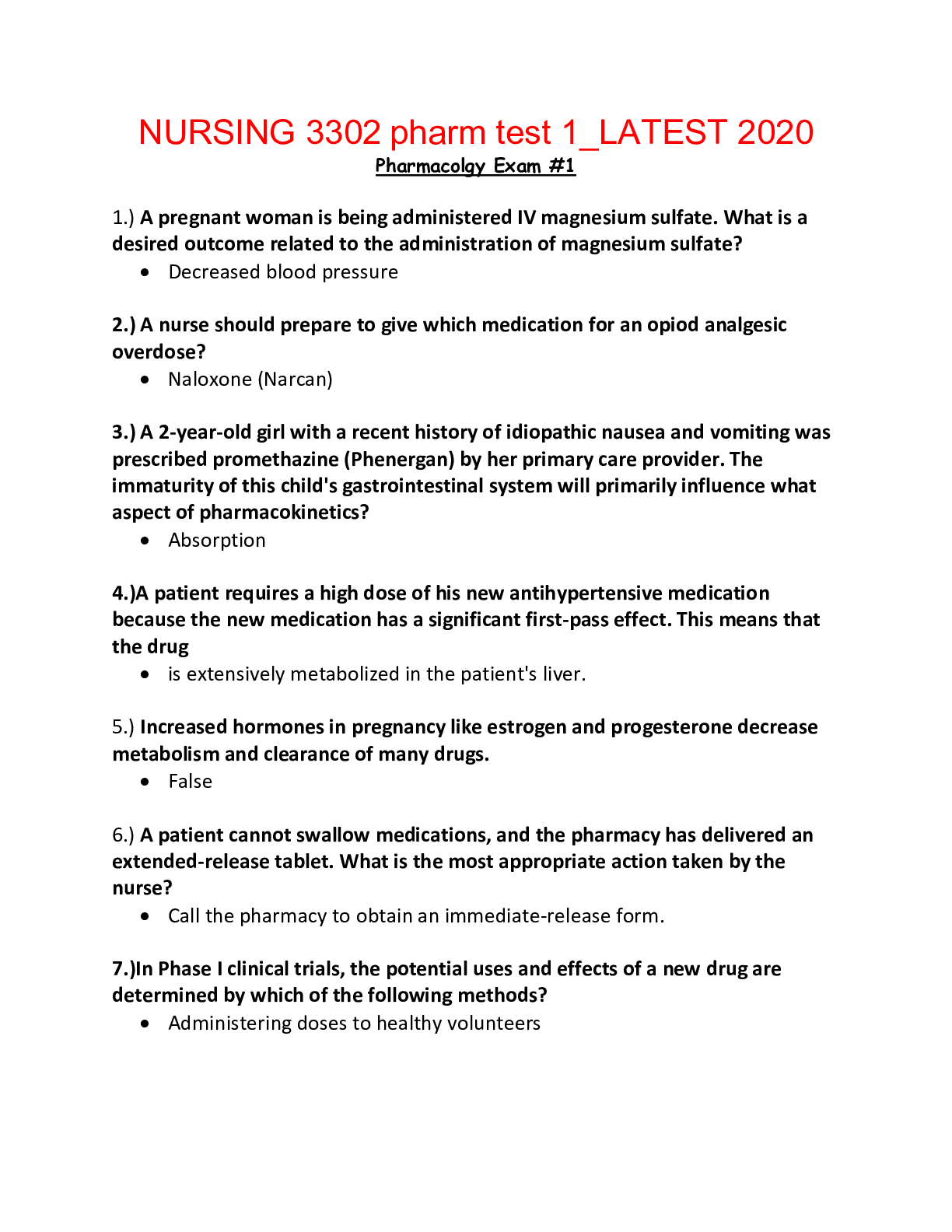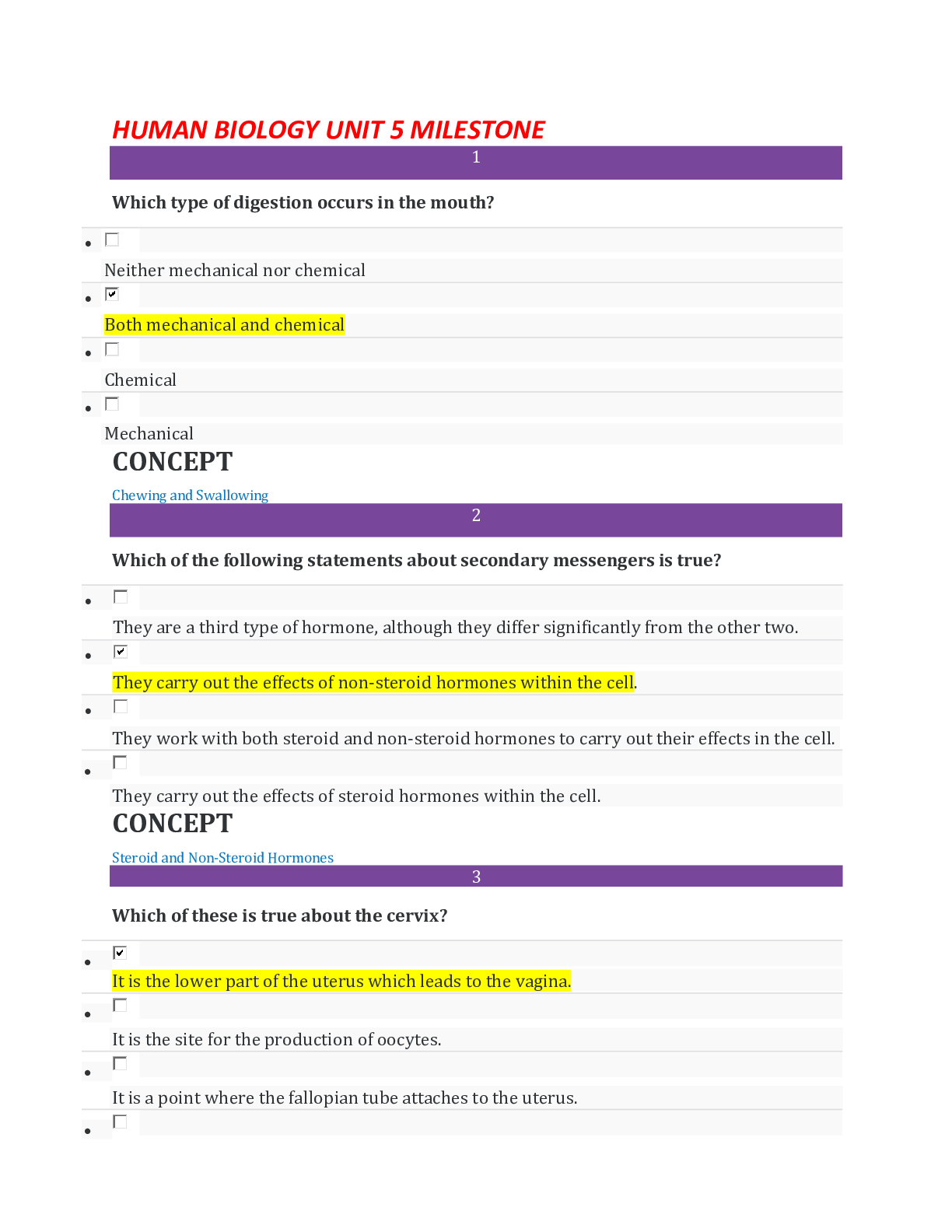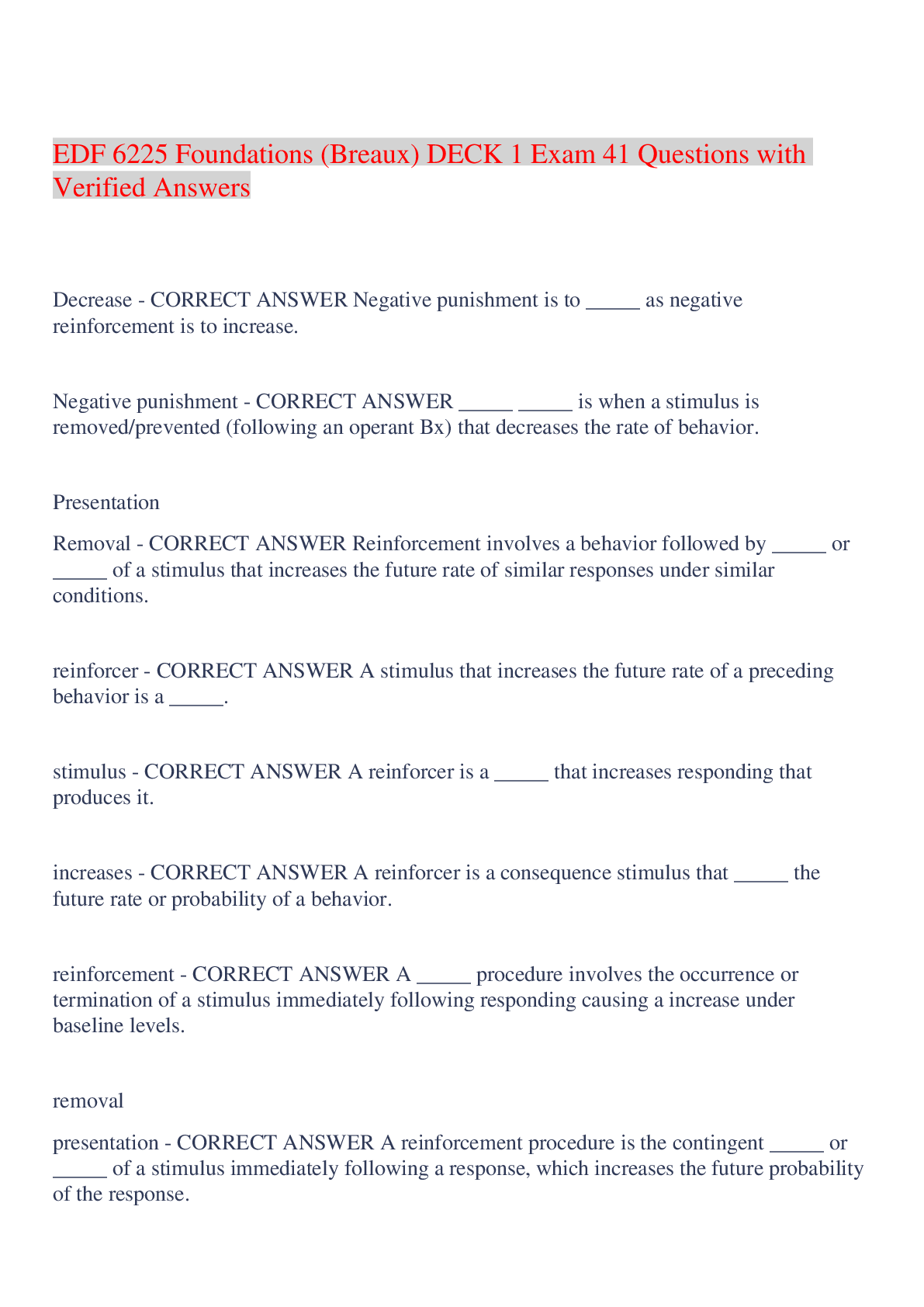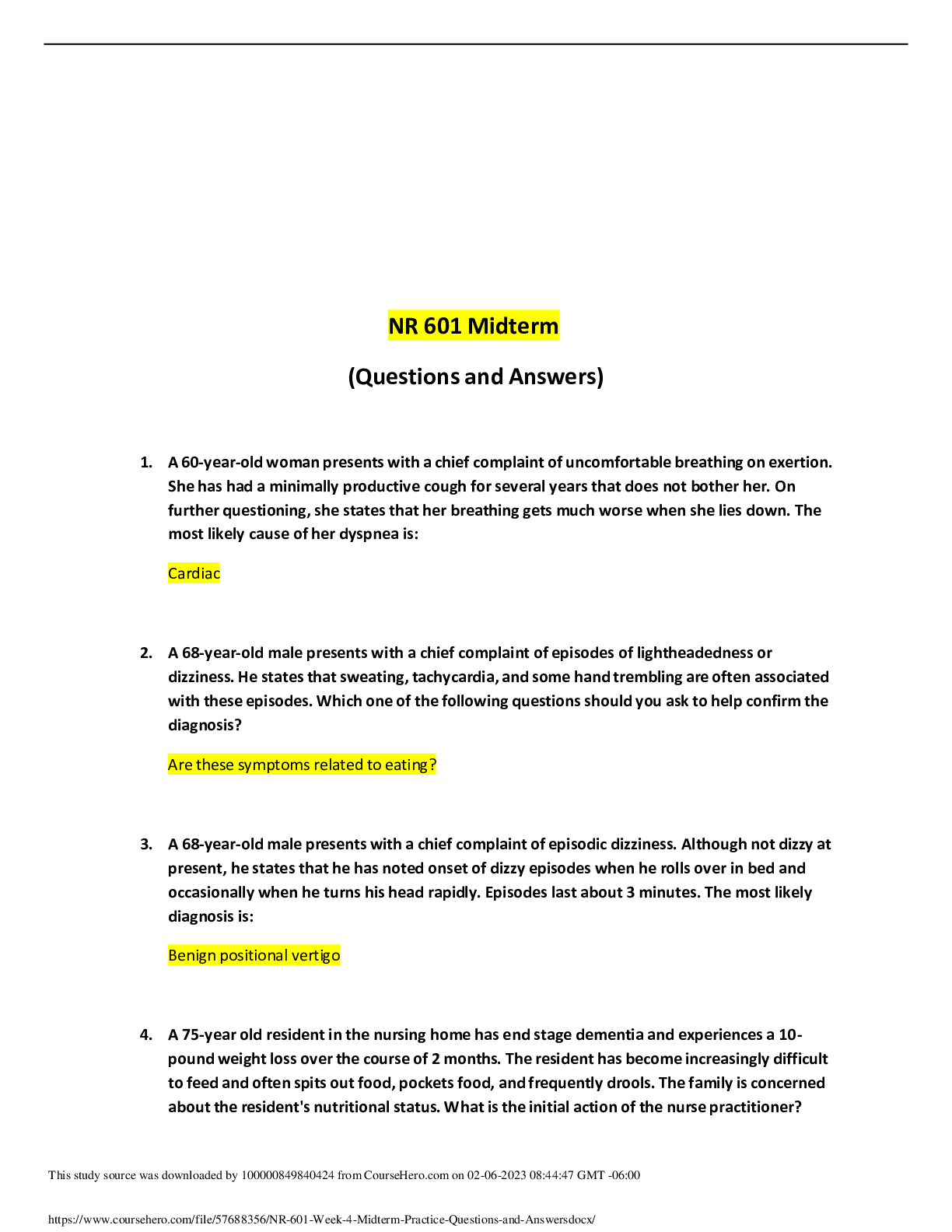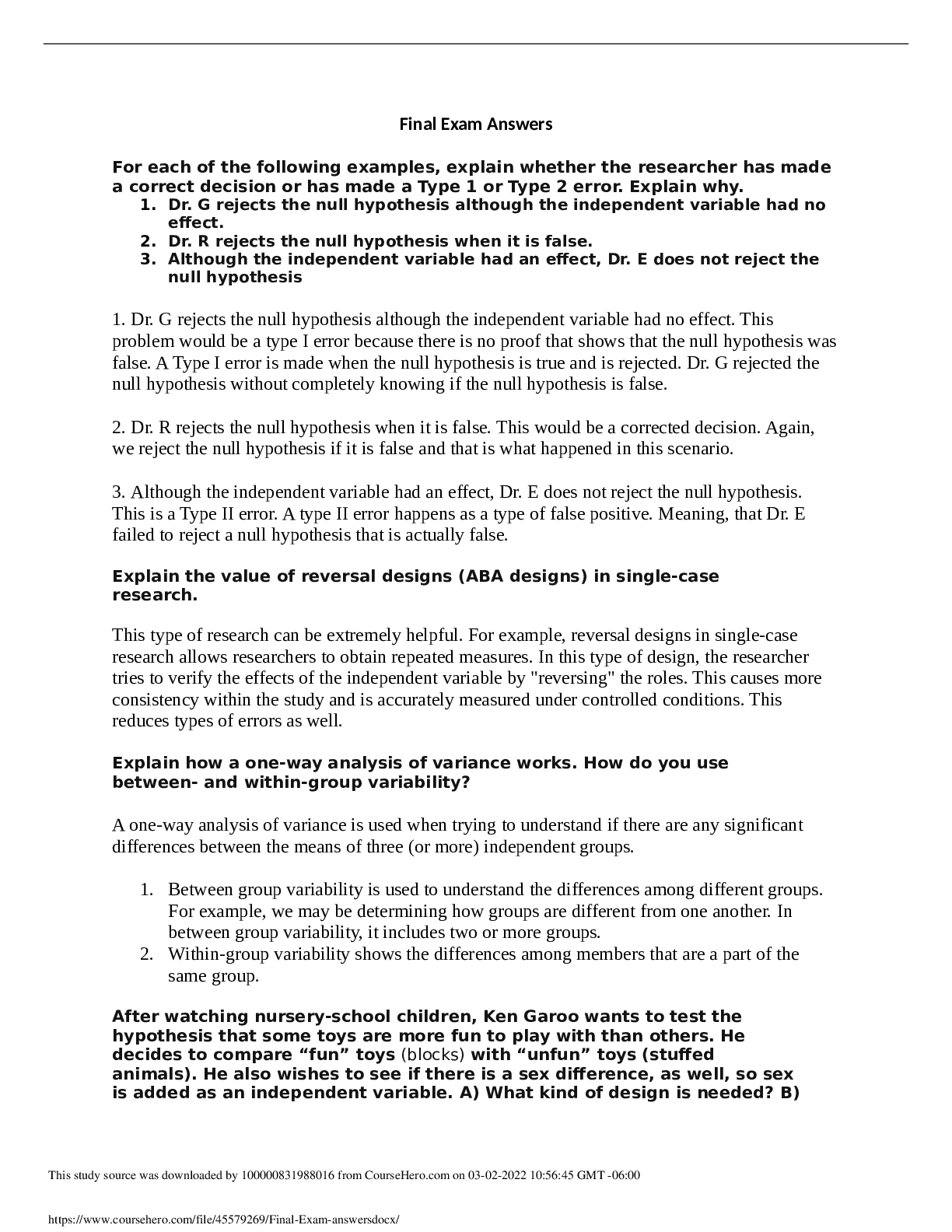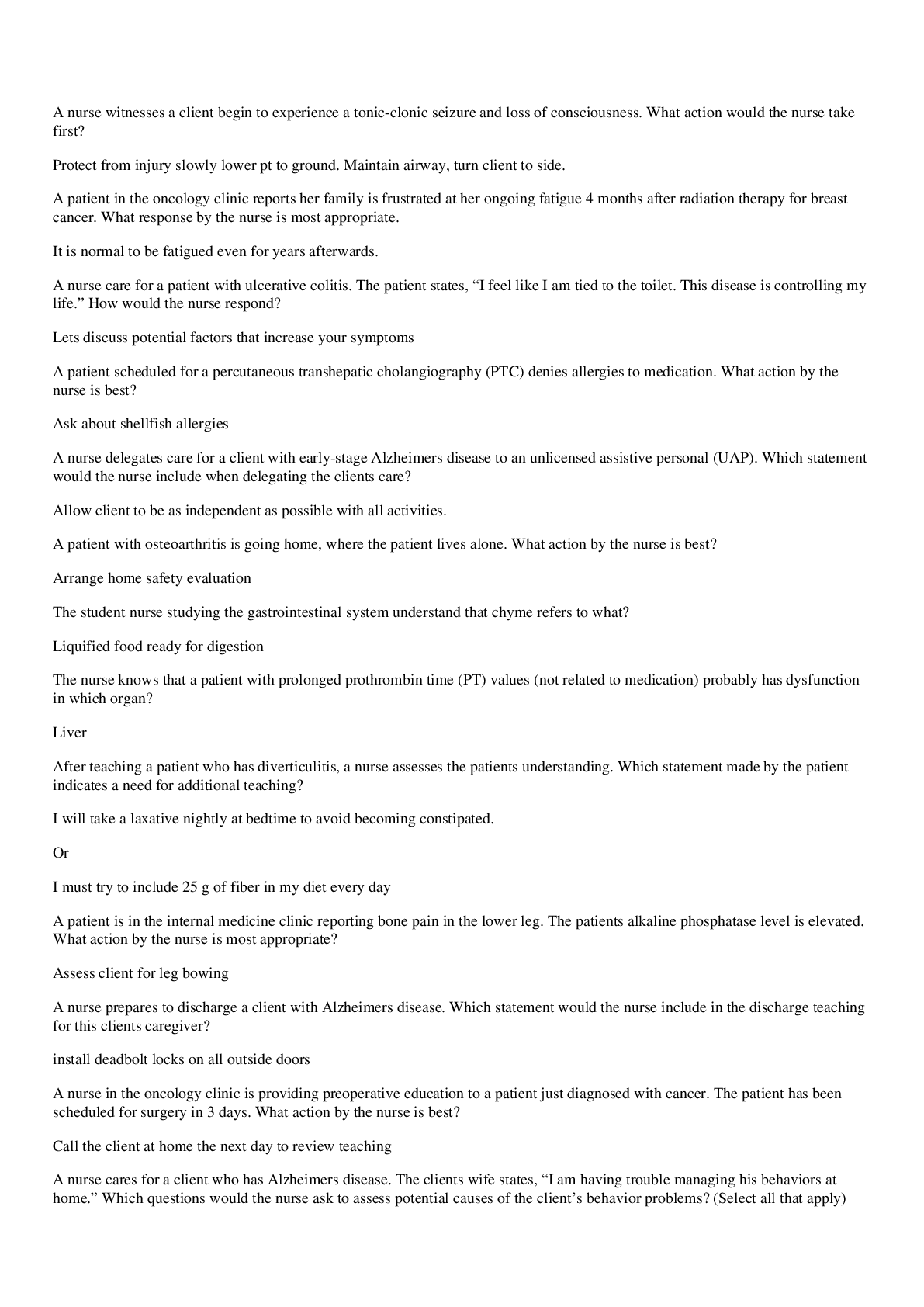NURS 5322 PHARM-WEEK 5-8 QUIZ and Answers,100% CORRECT
Document Content and Description Below
NURS 5322 PHARM-WEEK 5-8 QUIZ and Answers 1. Which of the following classes of drugs is contraindicated in heart failure? 1. Long-acting dihydropyridines 2. Alpha-beta blockers 3. ... Nitrates 4. Calcium channel blockers 2. When prescribing tacrolimus (Protopic) to treat atopic dermatitis patients should be informed that: 1. The FDA has issued a Black Box warning about the use of tacrolimus and the develo and humans. 2. Tacrolimus is the most effective if it is used continuously for 4 to 6 months. 3. Tacrolimus should be spread generously over the affected area. 4. The FDA recommends patients be screened for cancer before prescribing tacrolimu 3. When considering which cholesterol-lowering drug to prescribe, which factor determines the type and intensity of treatment? 1. Total LDL 2. Fasting total cholesterol 3. Fasting HDL 4. Coronary artery disease risk level 4. What is considered the order of statin strength from lowest effect to highest? 1. Lovastatin, Simvastatin, Rosuvastatin 2. Rosuvastatin, Lovastatin, Atorvastatin 3. Atorvastatin, Rosuvastatin, Simvastatin 4. Simvastatin, Atorvastatin, Lovastatin 5. What does the provider understand about the issue of “Diabetic Renal Protection” with angiotensin-converting enzyme (ACE) medications? Diabetes mellitus patients: 1. Have a reduced rate of renal progression, but still need to be discontinued when ad 2. Who start these medications never progress to renal nephropathy 3. Without renal issues are the only ones who benefit from ACE protection 4. With early renal dysfunction will see it reverse when on ACE medications 6. The first-line treatment for cough related to an upper respiratory tract infection (URI) in a 5-year-old child is: 1. Chlorpheniramine and dextromethorphan syrup (Nyquil for Kids) 2. Fluids and symptomatic care 3. Guaifenesin and codeine syrup (Tussin AC) 4. Dextromethorphan and guaifenesin syrup (Robitussin DM for Kids) 7. The first-line therapy for mild-persistent asthma is: 1. Long-acting beta-2-agonists 2. High-dose montelukast 3. Theophylline 4. Low-dose inhaled corticosteroids 8. Situations that suggest referral to a specialist is appropriate include: 1. When chronic stable angina becomes unpredictable in its characteristics and precip 2. When a post-myocardial infarction patient develops new-onset angina 3. When standard therapy is not successful in improving exercise tolerance or reducin 4. All of the above 9. Ray has been diagnosed with hypertension and an angiotensin-converting enzyme inhibitor is determined to be needed. Prior to prescribing this drug, the NP should assess for: 1. Impotence 2. Decreased renal function 3. Hypokalemia 4. Inability to concentrate 10. Patients who have angina, regardless of class, who are also diabetic, should be on: 1. Beta blockers 2. ACE inhibitors 3. Nitrates 4. Calcium channel blockers 11. Omega 3 fatty acids are best used to help treat: 1. High HDL 2. Low LDL 3. Any high lipid value 4. High triglycerides 12. Montelukast (Singulair) may be prescribed for: 1. A 6-year-old child with exercise-induced asthma 2. A 2-year-old child with moderate persistent asthma 3. An 18-month-old child with seasonal allergic rhinitis 4. None of the above; montelukast is not approved for use in children 13. Martin is a 60-year-old patient with hypertension. The first-line decongestant to prescribe would be: 1. Nasal azelastine 2. Nasal oxymetazoline 3. Oral pseudoephedrine 4. Oral phenylephrine 14. Long-acting beta-agonists (LTBAs) received a Black Box Warning from the U.S. Food and Drug Administration due to the: 1. Risk for life-threatening alterations in electrolytes 2. Increased risk of asthma-related deaths when LTBAs are used 3. Risk of life-threatening dermatological reactions 4. Increased incidence of cardiac events when LTBAs are used 15. Joanne is a 60-year-old patient with an LDL of 132 and a family history of coronary artery disease. She has already tried diet changes (increased fiber and plant sterols) to lower her LDL and after 6 months her LDL is slightly higher. The next step in her treatment would be: 1. A fibric acid derivative 2. Sterols 3. Niacin 4. A statin 16. Heart failure is a chronic condition that can be adequately managed in primary care. However, consultation with or referral to a cardiologist is appropriate when: 1. Symptoms markedly worsen or the patient becomes hypotensive and has syncope 2. There is evidence of progressive renal insufficiency or failure 3. The patient remains symptomatic on optimal doses of an ACE inhibitor, a beta block 4. Any of the above 17. Harold, a 42-year-old African American, has moderate persistent asthma. Which of the following asthma medications should be used cautiously, if at all? 1. Albuterol, a short-acting beta-agonist 2. Montelukast, a leukotriene modifier 3. Salmeterol, an inhaled long-acting beta-agonist 4. Betamethasone, an inhaled corticosteroid 18. First-line therapy for hyperlipidemia is: 1. Statins 2. Niacin 3. Bile acid-binding resins 4. Lifestyle changes 19. Erik presents with one golden-crusted lesion at the site of an insect bite consistent with impetigo. His parents have limited finances and request the least expensive-treatment. Which medication would be the best choice for treatment? 1. Bacitracin and polymixin B (generic double antibiotic ointment) 2. Retapamulin (Altabax) 3. Oral cephalexin (Keflex) 4. Mupirocin (Bactroban) 20. Digoxin levels need to be monitored closely when the following medication is started: 1. Albuterol 2. Diphenhydramine 3. Loratadine 4. Ipratropium 21. Digoxin has a very limited role in treatment of heart failure. It is used mainly for patients with: 1. An audible S3 2. Mitral stenosis as a primary cause for heart failure 3. Renal insufficiency 4. Ejection fractions above 40% 22. Decongestants such as pseudoephedrine (Sudafed): 1. Are effective in treating the congestion children experience with the common cold 2. Should not be prescribed or recommended for children under 4 years of age 3. May cause drowsiness in patients of all ages 4. Are Schedule III drugs in all states 23. Angiotensin-converting enzyme inhibitors are the drug of choice in treating hypertension in diabetic patients because they: 1. Improve insulin sensitivity 2. Improve renal hemodynamics 3. Reduce the production of angiotensin II 4. All of the above 24. A stepwise approach to the pharmacologic management of asthma: 1. Is used when asthma is severe and requires daily steroids 2. Begins with determining the severity of asthma and assessing asthma control 3. Allows for each provider to determine their personal approach to the care of asthm 4. Provides a framework for the management of severe asthmatics, but is not as helpf intermittent asthma 25. A patient has been prescribed silver sulfadiazine (Silvadene) cream to treat burns on his leg. Normal adverse effects of silver sulfadiazine cream include: 1. Wo rse nin g of bur n sy mp to ms bri efly bef ore res olu tio n 2. Hy per cal ce mia 3. A red , sca ly ras h tha t will res olv e wit h con tin ue d use 4. Tra nsi ent leu kop eni a on day s 2 to 4 tha t sho uld res olv e 25. The timing of NSAIDS for best control of severe menstrual cramps includes: 1 Taking them for 2-3 days prior to the start of . bleeding 2 They have not been found to be helpful at all . 3 Taking them 2-3 times a day during the first . 2 days 4 Taking them every 2-3 hours . 24. Hot flashes are often a concern during menopause. Which of the following may help in reducing them? 1 Drink one caffeinated liquid per day . 2 Take progesterone supplementation . 3 Increase intake of carrots, yams, and soy . products 4 Exercise 20-40 minutes/day . 23. Since 40% of bone accrual occurs during adolescence, building bone during this time is critical. Ways to improve bone accrual in adolescents include: 1 Encouraging a daily dietary intake of 1,300 mg of calcium and 400 IU of . vitamin D 2 Fostering the intake of iron mainly in green and leafy vegetables . 3 Use of bisphosphonates early if dual energy X-ray absorptiometry (DEXA) . scans show limited bone accrual 4 Avoiding all birth control methods that include progesterone . 22. Which of the following drug classes is associated with significant differences in metabolism based on gender? 1 Angiotensin-converting-enzyme (ACE) . inhibitors 2 Serotonin reuptake inhibitors . 3 Antibiotics . 4 Beta blockers . 21. Intimate partner violence is a serious public health problem. It should be screened for: 1 Throughout pregnancy . 2 When a women is being seen for symptoms of . depression 3 At every encounter within the health-care . system 4 If a sexually transmitted disease is diagnosed . 20. When a patient is prescribed nicotine nasal spray for tobacco cessation, instructions include: 1 Inhale deeply with each dose to ensure deposition in the lungs. . 2 If they have a sensation of “head rush” this indicates the medication is . working well. 3 The dose is one to two sprays in each nostril per hour, not to exceed 40 . sprays per day. 4 Nicotine spray may be used for up to 12 continuous months. . 19. Migraines in pregnancy may be safely treated with: 1. Acetaminophen with codeine (Tylenol #3) 2. Ergotamine tablets (Ergostat) 3. Dihydroergotamine (DHE) 4. Sumatriptan (Imitrex) 18. A first-line drug for abortive therapy in simple migraine is: 1 Naproxen (Aleve) . 2 Butorphanol nasal spray (Stadol . NS) 3 Sumatriptan (Imitrex) . 4 Butalbital and acetaminophen . (Fioricet) 17. Question 17 A contraindication to the use of combined contraceptives is: 1 Being overweight . 2 Recent pregnancy . 3 Adolescence (not approved for . this age) 4 A history of clotting disorder . 16. Patients taking hormonal contraceptives and hormone replacement therapy need to take the drug daily at the same time to prevent: 1 Breakthrough bleeding . 2 Nausea . 3 Pregnancy . 4 Breast tenderness . 15. Absolute contraindications that clinicians must consider when initiating estrogen therapy include: 1 Undiagnosed dysfunctional uterine bleeding . 2 Deep vein or arterial thromboemboli within the prior year . 3 Endometriosis . 4 1 and 2 . 5 All of the above . 14. Effects of estrogen include: 1 Regulation of the menstrual cycle . 2 Maintenance of bone density by increasing bone reabsorption . 3 Maintenance of the normal structure of the skin and blood vessels . 4 A and C . 5 All of the above . 13. Androgens are indicated for: 1 Symptomatic treatment for male deficiency . 2 Female libido, endometriosis, and postmenopausal symptoms . 3 Increased muscle mass . 4 Symptomatic treatment in both sexes for cancer and HIV . 5 1, 2, and 4 . 6 All of the above . 12. Men who are prescribed an erectile dysfunction drug such as sildenafil (Viagra) should be warned about the risk for: 1 Impotence when combined with . antihypertensives 2 Fatal hypotension if combined with nitrates . 3 Weight gain if combined with . antidepressants 4 All of the above . 11. A 22-year-old woman receives a prescription for oral contraceptives. Education for this patient includes: 1 Advising that she may miss two pills in a row and not be concerned about . pregnancy 2 Recommending that her next follow-up visit is in 1 year for a refill and . annual exam 3 Counseling regarding decreasing or not smoking while taking oral . contraceptives 4 Advising a monthly pregnancy test for the first 3 months she is taking the . contraceptive 10. Absolute contraindications to estrogen therapy include: 1 History of tension . headaches 2 Orthostatic hypotension . 3 History of any type of . cancer 4 Clotting disorders . 9. Monitoring for a patient who is using androgens includes evaluation of: 1 Urine protein and potassium levels . 2 Lipid levels and liver function tests . 3 Serum potassium and magnesium levels . 4 Complete blood count and C-reactive . protein levels 8. The U.S. Food and Drug Administration warns that androgens may cause: 1 Orthostatic . hypotension 2 Acne . 3 Peliosis hepatis . 4 Menstrual . irregularities 7. When prescribing Adderall (amphetamine and dextroamphetamine) to adults with ADHD the nurse practitioner will need to monitor: 1 Urine ketone . levels 2 Blood pressure . 3 Liver function . 4 Blood glucose . levels 6. Antonia is a 3-year-old child who has a history of status epilepticus. Along with her routine antiseizure medication, she should also have a home prescription for to be used for an episode of status epilepticus. 1 IV phenobarbital . 2 IV phenytoin (Dilantin) . 3 Rectal diazepam (Diastat) . 4 Oral carbamazepine . (Tegretol) 5. Activation of central alpha2 receptors results in inhibition of cardioacceleration and centers in the brain. 1 Vasodilation . 2 Vasoconstricti . on 3 Respiratory . 4 Cardiovascula . r 4. Scopolamine can be used to prevent the nausea and vomiting associated with motion sickness. The patient is taught to: 1 Place the tablet under the tongue and allow it to dissolve. . 2 Swallow the tablet 1 hour before traveling where motion sickness is . possible. 3 Apply the transdermal disk at least 4 hours before the antiemetic . effect is desired. 4 Change the transdermal disk daily for maximal effect. . 3. Nicotine has a variety of effects on nicotinic receptors throughout the body. Which of the following is NOT an effect of nicotine? 1 Release of dopamine at the pleasure center . 2 Stimulation of the locus coeruleus . 3 Vasodilation and decreased heart rate . 4 Increased secretion of gastric acid and motility of the GI . smooth muscle 2. Combined alpha-beta antagonists are used to reduce the progression of heart failure because they: 1 Increase renal vascular resistance . 2 Vasodilate the peripheral vasculature . 3 Reduce atherosclerosis secondary to elevated serum . lipoproteins 4 Decrease cardiac output . 1. John has clonidine, a centrally acting adrenergic blocker, prescribed for his hypertension. He should: 1 Not miss a dose or stop taking the drug because of potential rebound . hypertension 2 Reduce fluid intake to less than 2 liters per day to prevent fluid . retention 3 Increase fiber in the diet to treat any diarrhea that may occur . 4 Avoid sitting for long periods, as this can lead to deep vein . thrombosis [Show More]
Last updated: 2 years ago
Preview 1 out of 21 pages

Buy this document to get the full access instantly
Instant Download Access after purchase
Buy NowInstant download
We Accept:

Reviews( 0 )
$16.00
Can't find what you want? Try our AI powered Search
Document information
Connected school, study & course
About the document
Uploaded On
Oct 15, 2022
Number of pages
21
Written in
Additional information
This document has been written for:
Uploaded
Oct 15, 2022
Downloads
0
Views
61


